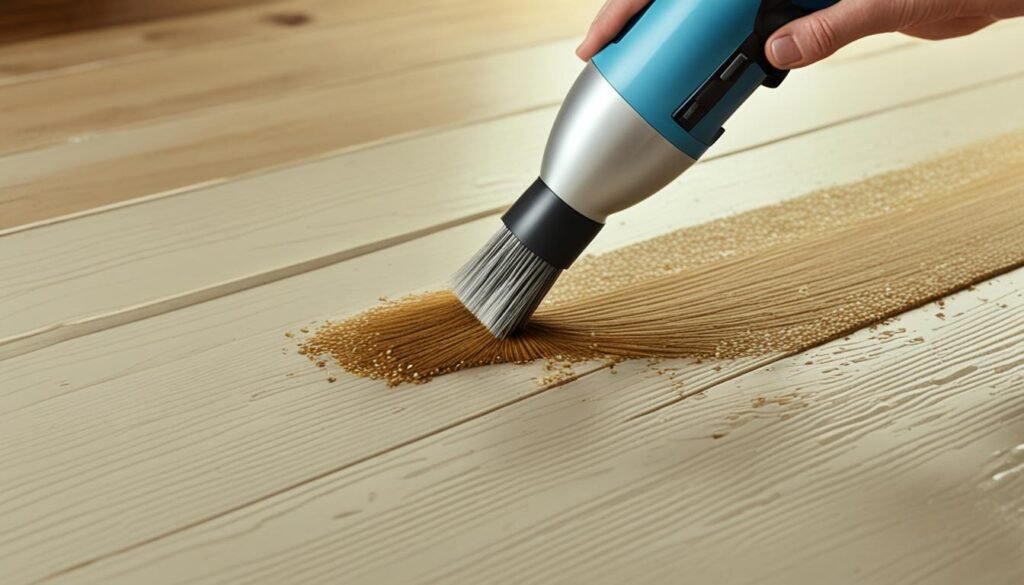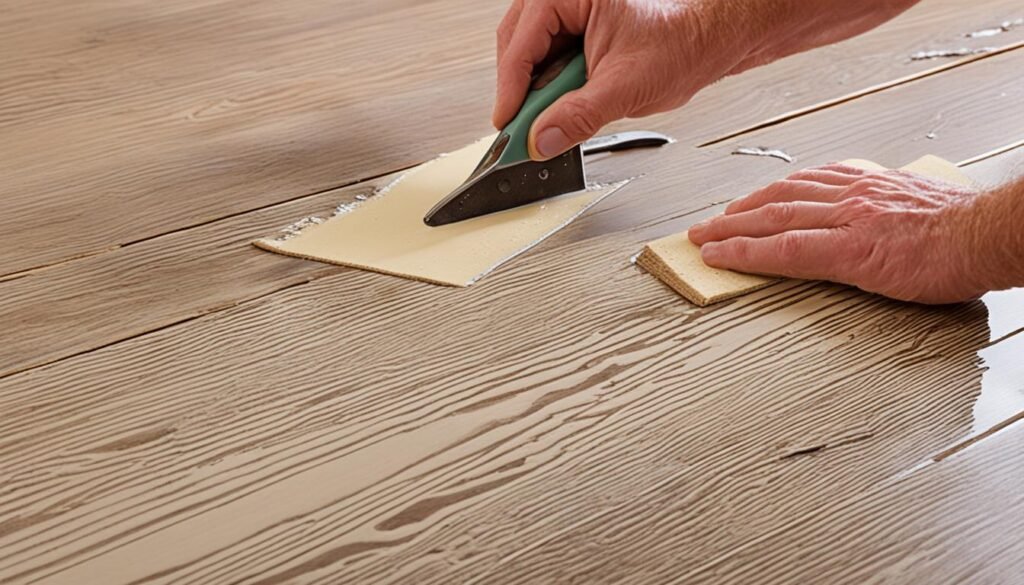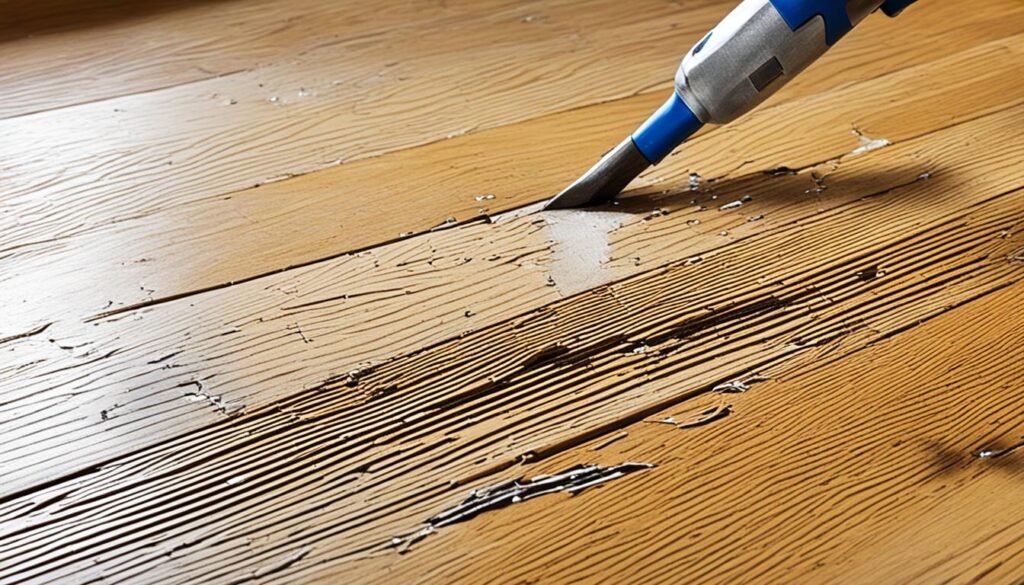Did you know water damage costs over $9 billion to US homeowners yearly? A big part of this is due to engineered wood floors, a favorite in many homes. If your engineered wood floors get wet, acting quickly is key to reduce damage and fix them. This guide will show you how to spot, check, and fix water-damaged engineered wood floors, for both small and big issues.
Key Takeaways
- Water and wood don’t mix – fast action is crucial to prevent further damage.
- The extent of the damage can vary based on factors like exposure time, floor type, and severity.
- Learn to identify the signs of water damage on engineered wood floors.
- Discover proven techniques for repairing minor and severe water damage.
- Protect your investment by understanding how to prevent future water damage.
How to Identify Water Damage on Engineered Wood Floors
Spotting water damage on engineered wood floors is key to quick action and stopping further damage. Knowing these signs can help you fix the issue early, saving you from expensive repairs or even replacing the whole floor.
Signs of Water Damage
If you think your engineered wood floor has gotten wet, watch for these signs:
- Staining and discoloration: Water can cause unsightly stains and discoloration on the floor.
- Cupping: The planks’ edges might rise more than the middle, making them look cupped.
- Crowning: The planks’ middle might swell, creating a crowning effect.
- Buckling: Too much moisture can make the flooring buckle and warp.
- Popping nails: Water damage can make the nails holding the flooring pop up.
- Lifting floorboards: You might see the flooring lifting, especially at the planks’ ends.
- Mold growth: Mold can start growing within 48 hours of flooding, which is a health risk.
Normal hardwood floors have moisture levels of 6-12%. But a flooded engineered floor can have moisture up to 40%. This can cause severe damage if not fixed.
“Identifying water damage early is crucial for preventing further deterioration and costly repairs on your engineered wood floors.”
Knowing these common issues with water-damaged engineered flooring lets you act fast. This can help reduce the damage to your home’s interior.
How to Repair Minor Water Damage on Engineered Floors
If you’ve found minor water damage on your engineered wood floors, like scratches or dents, don’t worry. You can fix these easily with a few steps. Let’s explore how to DIY engineered wood floor water damage repair and fix minor water damage on engineered flooring.
First, clean the damaged area well. Remove any dirt or loose material. This makes sure the surface is ready for repair.
- Apply a wood filler to the damaged spots, following the product’s instructions. Let it dry fully.
- After drying, sand the area until it’s smooth and matches the floor.
- To finish, reapply the finish to the area, matching it with the rest of the floor. Make sure the edges blend well.
If planks are loose or lifted, you can fix them with glue. Put wood glue under the plank, press it down, and let the glue dry. After drying, sand and refinish the area for a perfect look.
“With the right techniques, you can revive your engineered wood floors and make them look as good as new.”
Remember, fixing scratches and dents on engineered wood requires patience and care. Work slowly and carefully, and your floors will look great again soon.

Fixing minor water damage on your engineered flooring quickly keeps your home looking good. With some effort and focus, you can fix minor water damage on engineered flooring. Enjoy your beautiful, well-kept engineered wood floors for many years.
How to Repair Severe Water Damage on Engineered Wood Floors
Dealing with severe water damage on engineered wood floors means you need a detailed plan. You must fix the problem and fully restore the damaged area to stop further damage.
Here are the key steps to repair water-damaged engineered hardwood:
- Identify and Address the Source of Water Intrusion
- Find where the water is coming from to stop it and prevent more damage.
- This could mean fixing a leak, solving a plumbing problem, or sealing water entry points.
- Thoroughly Dry the Affected Area
- Use fans, dehumidifiers, or other drying tools to dry the damaged flooring completely.
- This drying process can take a few days, as the wood must go back to its normal state and moisture level.
- Sand and Refinish the Damaged Area
- After drying, sand the damaged area to fix warping, cupping, or other damage.
- Then, refinish the area to blend with the rest of the floor, making it look new again.
If the water damage is big or complicated, getting help from a professional is wise. Companies like FloodFixers have the skills and tools to find the problem, dry the floor, and fix it. They can fix water-damaged engineered hardwood and make your floor look great again.

Fixing severe water damage on engineered wood floors needs a careful plan. First, find the water source, then dry the area well, and finally, refinish the damaged part. This way, you can repair water damaged engineered wood floors and keep them safe from more problems. With the right steps and careful work, your engineered hardwood flooring can look beautiful again.
Conclusion
Fixing damaged engineered flooring is doable with the right tools and knowledge. Check your floors often and fix any engineered wood flooring water damage tips quickly. But, if the damage is big or you’re not sure what to do, call a pro like FloodFixers for the best outcome.
Keeping your engineered floors safe from water damage is crucial. With the right care, your floors will stay beautiful and comfy for many years. This care keeps your home looking great.
This guide shows how to spot, fix, and stop water damage on your engineered wood floors. Being proactive and quick to act is key to keeping your floors in top shape. It also helps protect your investment and keeps your floors looking beautiful.


